VLF Radio Transmission Test from Heidelberg, 2011-11-26/27
Introduction
Very Low Frequency
radio signals are radio waves that have an exceptionally long
wavelength, tens of kms and a frequency in the audio range.
These waves travel below the ionosphere, reflecting with low loss
from the ground and the ionosphere's D-region and are used for
geophysical measurements and military communications with submerged
submarines since the waves penetrate sea water up to 50m.
It is difficult to transmit a signal at VLF. Very long antennas and
high voltages are required in order to transmit even a weak signal.
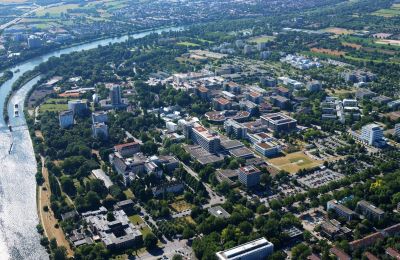
In this test, amateur radio stations, callsign DK7FC built and operated by
Stefan Schäfer,
transmits from
Heidelberg University
.
The frequency is around 9kHz which is lower than most military transmissions
and this rare transmission provides an opportunity to test communications and
propagation in a region of spectrum otherwise devoid of man-made radio
transmissions.
Stefan has pioneered VLF transmission efforts by radio amateurs, proving
that it is possible to transmit a signal at these wavelengths using modest
equipment, and in the last two years has established steadily increasing
distance records using kite antennas, his signals having been received out
to a range of 2873km - a world record for amateur transmission. This test
is Stefan's first using a fixed antenna which allows much longer
transmissions to be made.
Transmission
Location: 49.410N,8.706E;
Frequency/Time: 8970.000Hz 2011-11-26_17:00 to 2011-11-26_21:00
8970.005Hz 2011-11-26_21:45 to 2011-11-27_10:00
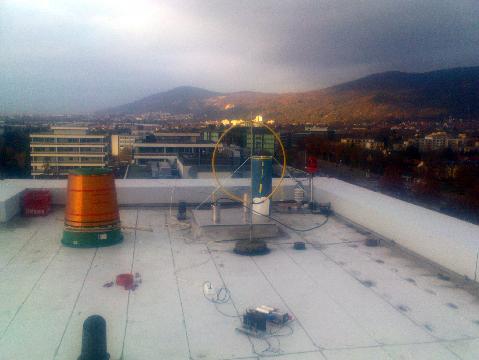 The antenna is 70m long and 30m high, strung between two buildings
at the university.
The PA and loading coil are located
on the roof at one end, photo right.
The loading coil is 550mH with 30mH variometer, DC resistance 320 Ohms,
overall loss resistance is 575 Ohms. A plate capacitor of about 100pF
was required for tuning as the loading coil was intended for a longer
(kite) antenna.
The antenna is 70m long and 30m high, strung between two buildings
at the university.
The PA and loading coil are located
on the roof at one end, photo right.
The loading coil is 550mH with 30mH variometer, DC resistance 320 Ohms,
overall loss resistance is 575 Ohms. A plate capacitor of about 100pF
was required for tuning as the loading coil was intended for a longer
(kite) antenna.
With 350W drive the coil current is 780mA producing an antenna voltage
of around 24kV and a current of about 640mA into the 470pF antenna
capacitance.
The power was limited by the tendency of the
improvised plate capacitor to form 8cm arcs.
The effective height of the antenna is unknown and the ERP is probably
in the region of 50 to 200uW.
The exciter is a PC running
Spectrum Lab
locked to a 10kHz GPS reference. The drive signal goes to the PA
via optical fibre which prevents interference to the GPS frequency
locking.
Reception Notes - Todmorden, UK
Location: 53.703N,2.072W;
Range 883.5 km;
H-field reception is by orthogonal loops of area 20m^2,
transformer-matched for optimum noise
figure into an LT1028 preamplifier to obtain a system noise floor
of around 0.15fT in 1Hz bandwidth at 9kHz. The E-field receiver uses
a 2 metre monopole antenna and
a JFET front end with a system noise floor around 0.1uV/m in 1Hz at 9kHz.
The three amplified signals are
digitised at 24 bit resolution with a sample rate of 192k/sec using
M-Audio 192 PC soundcards. The digitised signals are timestamped by
a GPS reference, converted to UT synchronous samples,
then stored for post-processing.
In post-processing the signals are phase equalised and band limited, and
sferics are blanked. An array of Goertzel filters are employed to
extract complex amplitudes of the three signals over a narrow spectrum
surrounding the signal.
The signal from Heidelberg was very steady during the test, with little
amplitude or phase variation. Background noise was mostly from the
south west and reached a peak of 55fT in 1Hz at 22:00 and steadily
declined after that. The combination of antenna orientation and
sferic blanking reduced the average noise to a maximum of 4fT in
1Hz.
The signal was strong enough
in bandwidths of less than 2mHz to allow the characteristics of the incident
signal to be measured at 5 minute intervals in 10 minute integrations.
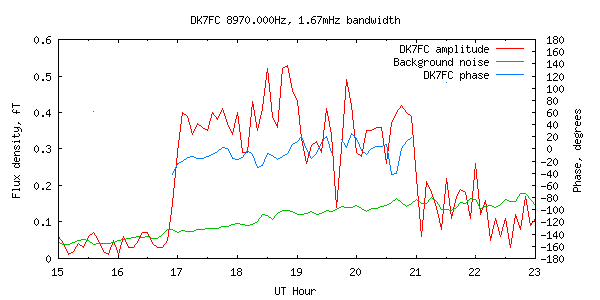 |
The first transmission, at 8970.000Hz.
|
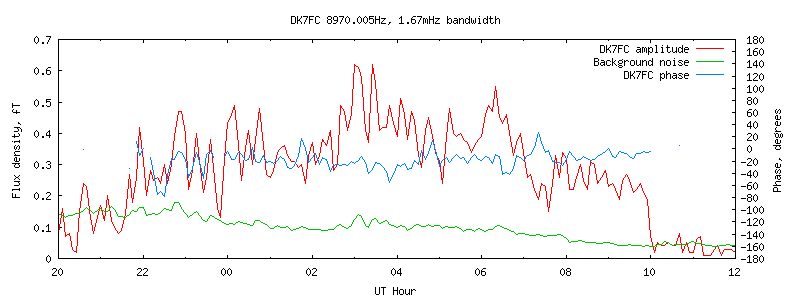 |
The second transmission, at 8970.005Hz. Linear regression
of the phase produces an average frequency of
8970.0050006 Hz +/- 0.5uHz
|
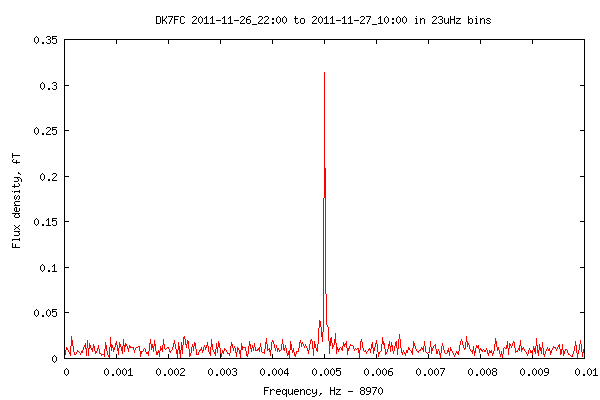 |
A spectrum of the second transmission reveals a beautiful
sharp line from the GPS locked transmitter.
The spectral peak is at 8970.0050040Hz +/-0.1uHz,
|
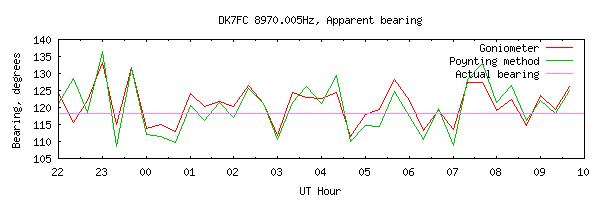 |
The apparent bearing of the signal, by two different methods. Most of the
variation is due to noise rather than propagation, as the two methods have
similar variance here. The signal was not strong enough to obtain a useful
NPE bearing. The average bearing by the Poynting method was 120.0 deg
and the true bearing to the transmitter is 118.3 deg.
|
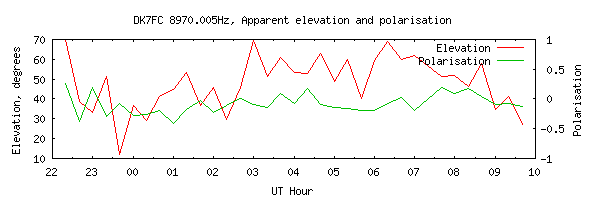 |
The apparent elevation and polarisation, with some considerable error
due to the relatively high noise floor of the E-field receiver. The
signal showed slight RH elliptical polarisation through most of the
night. It was not possible to determine the tilt angle of the
polarisation ellipse.
|
Reception Notes - Marlton, New Jersey
Location: 39.88889N,74.90556W. Eastern most border of FM29NV15KR;
Range: 6354 km;
This is an E-field receiver with a dipole probe and AD823 preamplifier.
Signal is captured at 16 bits resolution with 48k samples/second.
The digitised signal is timestamped
by GPS, converted to UT synchronous samples and stored for post-processing.
No signal was detected from DK7FC, with various integration times being
tested, including a full 12 hour spectrum using 23uHz bins, several
combinations of 6 hour and 3 hours integrations, both coherent and non-coherent.
The
receiver has a noise floor of about 0.25nV in 23uHz bandwidth and the VLF
background noise after sferic blanking is about 2.5nV.
In order to have been reliably detected, the signal
would have to have averaged
10nV or more over the 12 hour integration, and not have suffered more
than a few tens of degrees of phase disturbance.
The Alpha F1 signal at 11904.76190 Hz was received with less than 10 deg
phase variation from 01:00 to 04:00, suggesting that long range paths
at this time were fairly stable. Lack of reception was probably due
to the signal strength being well below 10nV rather than dispersion due to
variable propagation.
Communications
Following the long carrier test, DK7FC transmitted a message using
dual frequency Morse code with a dot length of 600 seconds and a frequency
shift of +/-25mHz. A spectrogram of this transmission is shown below,
 |
The callsign DK7FC, taking four hours to send.
|
The 23 bit message is easily readable with a 5 minute integration period.
Some trials were run to measure the bit errors that would have been
obtained if the
12 hour carrier transmission at 8970.005 had been sending a message using
binary phase shift keying. The results are shown below for a
selection of bit periods.
| 1 minute | 720 bits sent, 38 errors |
| 2 minutes | 360 bits sent, 12 errors |
| 3 minutes | 240 bits sent, 2 errors |
| 4 minutes | 180 bits sent, 2 errors |
| 6 minutes | 120 bits sent, 0 errors |
The persistent bit errors with 3 and 4 minute periods
occurred at about 22:07 and 01:48 UT
where the signal dropped into the noise for a minute or two.
It is likely that using an error-correcting encoding and DPSK, some 20 to
30 bits per hour could be reliably sent.
Research
The D-region of the ionosphere is difficult to study, being too low for
satellites and too high for balloons. Direct measurements are only
available by sounding rocket and therefore the properties of this region
have to be inferred by parameter fitting of propagation models
to measurements of VLF signals propagating in the Earth-ionosphere cavity.
A number of military transmitters provide useful signals at frequencies
above 18kHz, and these have been exploited with some success,
for example [1] and [2].
However, at lower frequencies there are no artificial signal sources
available. Results in the lower VLF have been obtained by analysis of
sferic and tweek waveforms, for example [3] and [4], but these methods rely
on the presence of lightning activity in suitable locations.
Beacon transmissions by radio amateurs at frequencies below 9kHz may offer
a useful signal for D-region studies. This test indicates that, despite
the relatively low ERP of the amateur transmission compared with military
stations, the signal received at several hundred km is sufficiently strong
for phase and bearing measurements at timescales above 300 seconds.
Limited sensitivity of the E-field receiver prevented accurate elevation
and polarisation to be determined on a 300 second average but results at
hour intervals appear to be quite possible.
Modeling
Modeling the propagation by ray tracing,
taking account of the first 20 sky waves and
the Norton surface wave, and assuming an effective antenna height of
15m, produces the following predictions for the signal at Todmorden:
| Midday | flux density: 0.27fT |
| Poynting bearing: 129.9 deg |
| Elevation: 25.0 deg |
| Polarisation: -0.20 |
| Midnight | Flux density: 0.58fT |
| Poynting bearing: 120.1 deg |
| Elevation: 22.0 deg |
| Polarisation: -0.10 |
The measured nightime flux density, polarisation, and the slight southwards shift
of the apparent bearing, all match the propagation model fairly well.
The received elevation was consistently much higher than predicted and suggests that
something is wrong with the E-field receiver calibration or phase
equalisation.
Unfortunately this particular model does not work beyond the caustic limit
so is unable to predict field strength at Marlton.
References
[1]
Thomson, N. R., M. A. Clilverd, and C. J. Rodger, Daytime Mid-Latitude
D-region Parameters at Solar Minimum from Short Path VLF Phase and Amplitude,
J. Geophys. Res., (in press), doi:10.1029/2010JA016248, 2011.
http://www.physics.otago.ac.nz/space/2010JA016248-pip.pdf
[2]
Thomson, N. R. (2010), Daytime tropical D region parameters from short path VLF phase and amplitude, J. Geophys. Res., 115, A09313, doi:10.1029/2010JA015355.
http://www.agu.org/pubs/crossref/2010/2010JA015355.shtml
[3]
Cheng, Z., S. A. Cummer, D. N. Baker, and S. G. Kanekal (2006), Nighttime D
region electron density profiles and variabilities inferred from broadband
measurements using VLF radio emissions from lightning, J. Geophys. Res.,
111, A05302, doi:10.1029/2005JA011308.
http://www.agu.org/pubs/crossref/2006/2005JA011308.shtml
[4]
Higher harmonic tweek sferics observed at low latitude: estimation of VLF
reflection heights and tweek propagation distance S. Kumar kumar_su@usp.ac.fj
A. Kishore V. Ramachandran School of Engineering and Physics, The University
of the South Pacific, Suva, Fiji
Ann. Geophys., 26, 1451 1459 2008-06-11
http://www.ann-geophys.net/26/1451/2008/angeo-26-1451-2008.pdf
http://en.scientificcommons.org/54313395
Paul Nicholson vlf0308@abelian.org
http://abelian.org
 The antenna is 70m long and 30m high, strung between two buildings
at the university.
The PA and loading coil are located
on the roof at one end, photo right.
The loading coil is 550mH with 30mH variometer, DC resistance 320 Ohms,
overall loss resistance is 575 Ohms. A plate capacitor of about 100pF
was required for tuning as the loading coil was intended for a longer
(kite) antenna.
The antenna is 70m long and 30m high, strung between two buildings
at the university.
The PA and loading coil are located
on the roof at one end, photo right.
The loading coil is 550mH with 30mH variometer, DC resistance 320 Ohms,
overall loss resistance is 575 Ohms. A plate capacitor of about 100pF
was required for tuning as the loading coil was intended for a longer
(kite) antenna.






